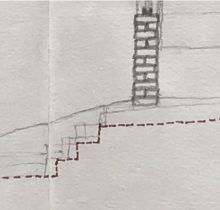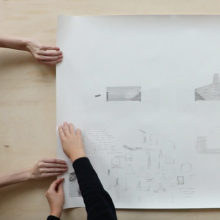Fragility
Sacred Grounds: (drawing) methods to generate alternative typologies and added value for fragile topographies
Starting from a fascination for (1) the topography and (2) the act of drawing, this research aims to investigate the potential of architectural interventions in fragile topographies, hence to critically question the moratorium that seems to rest on architectural interventions in these topographies, and to do this by means of drawing hypothetic typologies (speculative architectural design) that challenge existing typologies that our collective memory seems to take for granted. The underlying ethics at work in these design hypotheses is a search for adding value (Van Den Berghe 2010) to these topographies through the insertion of architecture.
This research starts from a research case in my master thesis project The Remembered, The Experienced, The Imagined, situated in one of the few remaining dune areas along the Belgian coastline. In this case, refuges have been designed in this fragile topography that—contrary to the predominant architectural typologies at the Belgian seaside—are not in contradiction with the true reason why people like to come to the sea. The immersion of this architecture into its topography prevails over the urge for architectural manifestation. It is an in-depth (re)search for an architecture for which almost disappearing is a key condition for adding value by means of architectural design.
This doctoral research will develop additional research cases by means of which will be investigated how and to what extent alternative typologies can be generated through speculative architectural design. Consequently to this first case, the new cases will be situated in the dune and polder landscape in the first stage of the research, and subsequently also in other fragile topographies like historical urban areas.
A PhD project by Louise De Brabander
Supervised by Jo Van Den Berghe
Co-supervised by Thierry Lagrange
Latest
 | 29.08.19 | On-site sketches / memo drawings |
 | 02.01.18 | Bootleg Film |